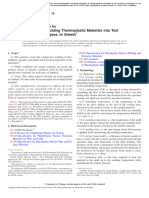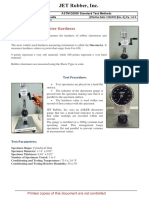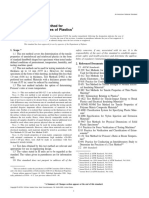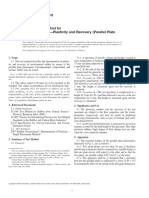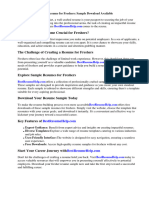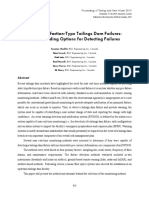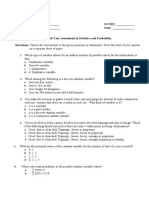Measuring Shrinkage From Mold Dimensions of Thermoplastics: Standard Test Method of
Uploaded by
sanhuei.ltdMeasuring Shrinkage From Mold Dimensions of Thermoplastics: Standard Test Method of
Uploaded by
sanhuei.ltdDesignation: D955 − 08 (Reapproved 2014)
Standard Test Method of
Measuring Shrinkage from Mold Dimensions of
Thermoplastics1
This standard is issued under the fixed designation D955; the number immediately following the designation indicates the year of
original adoption or, in the case of revision, the year of last revision. A number in parentheses indicates the year of last reapproval. A
superscript epsilon (´) indicates an editorial change since the last revision or reapproval.
This standard has been approved for use by agencies of the U.S. Department of Defense.
1. Scope D3641 Practice for Injection Molding Test Specimens of
1.1 This test method is intended to measure shrinkage from Thermoplastic Molding and Extrusion Materials
mold cavity to molded dimensions of thermoplastics when D4066 Classification System for Nylon Injection and Extru-
molded by compression or injection processes with specified sion Materials (PA)
process conditions. D4549 Classification System and Basis for Specification for
Polystyrene and Rubber-Modified Polystyrene Molding
1.2 This test method covers shrinkage measurements at 24 and Extrusion Materials (PS)
and 48 hours. D4703 Practice for Compression Molding Thermoplastic
1.3 This method will give comparable data based on stan- Materials into Test Specimens, Plaques, or Sheets
dard specimens and can not predict absolute values in actual D4976 Specification for Polyethylene Plastics Molding and
molded parts with varying flow paths, wall thicknesses, pres- Extrusion Materials
sure and temperature gradients and process conditions. Differ- D5947 Test Methods for Physical Dimensions of Solid
ences in mold shrinkage may also be observed among the three Plastics Specimens
specimen geometries described in this test method. D6778 Classification System and Basis for Specification for
1.4 The values stated in SI units are to be regarded as the Polyoxymethylene Molding and Extrusion Materials
standard. The values given in parentheses are given for (POM)
information only. D6779 Classification System for and Basis of Specification
for Polyamide Molding and Extrusion Materials (PA)
1.5 This standard does not purport to address all of the
E691 Practice for Conducting an Interlaboratory Study to
safety concerns, if any, associated with its use. It is the
Determine the Precision of a Test Method
responsibility of the user of this standard to establish appro-
priate safety and health practices and determine the applica- 2.2 ISO Standards:3
bility of regulatory limitations prior to use. ISO 293 Plastics—Compression Moulding Test Specimens
of Thermoplastic Materials
NOTE 1—This standard and ISO 294-3 are equivalent in the design of
specimen D2. This test method is equivalent to ISO 294-4 where Type D2 ISO 294-1 Plastics—Injection Moulding of Test Specimens
specimens and the procedure in Appendix X2 are used. of Thermoplastic Materials—Part 1: General Principles,
and Moulding of Multipurpose and Bar Test specimens
2. Referenced Documents ISO 294-3 Plastics—Injection Moulding of Test Specimens
2.1 ASTM Standards:2 of Thermoplastic Materials—Part 3: Small Plates
D618 Practice for Conditioning Plastics for Testing ISO 294-4 Plastics—Injection Moulding of Test
D788 Classification System for Poly(Methyl Methacrylate) Specimens—Part 4: Determination of Moulding Shrink-
age
--```,```,,,`,,,```,,,``,`,,,`-`-`,,`,,`,`,,`---
(PMMA) Molding and Extrusion Compounds
D883 Terminology Relating to Plastics
3. Terminology
1
This test method is under the jurisdiction of ASTM Committee D20 on Plastics 3.1 Definitions—General definitions of terms applying to
and is the direct responsibility of Subcommittee D20.09 on Specimen Preparation. this test method appear in Terminology D883.
Current edition approved Aug. 1, 2014. Published August 2014. Originally
approved in 1948. Last previous edition approved in 2008 as D955 - 08. DOI: 3.2 Definitions of Terms Specific to This Standard:
10.1520/D0955-08R14.
2
For referenced ASTM standards, visit the ASTM website, www.astm.org, or
contact ASTM Customer Service at service@astm.org. For Annual Book of ASTM
3
Standards volume information, refer to the standard’s Document Summary page on Available from American National Standards Institute (ANSI), 25 W. 43rd St.,
the ASTM website. 4th Floor, New York, NY 10036, http://www.ansi.org.
Copyright © ASTM International, 100 Barr Harbor Drive, PO Box C700, West Conshohocken, PA 19428-2959. United States
Copyright ASTM International
Provided by IHS under license with ASTM
1Licensee=Hong Kong Polytechnic University/9976803100
No reproduction or networking permitted without license from IHS Not for Resale, 11/22/2015 20:46:21 MST
D955 − 08 (2014)
3.2.1 jetting, n—non-uniform multi-directional flow front 6. Sample Preparation
apparent on the surface of the mold due to rapid filling of the 6.1 Some materials require special treatment before they are
mold cavity. molded. For example, thermoplastics, which absorb moisture
must be dried before molding. For required conditions for
4. Summary of Test Method
sample preparation, refer to the appropriate material specifica-
4.1 The principle of this test method is to compare mold tion or the manufacturer’s recommendations if no specification
cavity dimensions with specimen dimensions and report the is available. The preparation given to the material prior to
differences in percent. molding shall be recorded and reported.
5. Significance and Use 7. Apparatus
5.1 Injection Molding—In injection molding, the difference 7.1 Injection Mold—Specimens shall be molded in a two
between the dimensions of a mold cavity and of the molded cavity mold conforming with dimensions as shown in Figs. 1
specimen may vary according to the design of the mold and and 2 for the 60 × 60-mm plaque specimen (Type D2), Fig. 3
operation of the molding process. Factors such as mold and for the 12.7 by 127-mm bar specimen (Type A) and Fig. 4 for
melt temperature, fill times, and packing conditions are known the 100 mm by 3.2-mm disk specimen (Type B). Pressure
to affect shrinkage significantly. Adherence to the specified transducers for monitoring the pressure in at least one cavity
mold design (see 7.1) and specifications outlined in Practice are mandatory for Type D2. Mold shrinkage measurements
D3641 or ISO 294-4 or the appropriate material specification shall be made on specimens that have been molded at one of
will improve the reproducibility of the test. the following cavity pressures 6 3 % from the selected
5.2 Compression Molding—In compression molding, the pressure: 20 MPa, 40 MPa, 60 MPa, 80 MPa, 100 MPa, or as
difference between the dimensions of a mold cavity and of the specified in the appropriate material specification. Pressure
molded specimen may vary according to the design of the mold transducers are recommended, but not mandatory for speci-
and operation of the molding process. Factors, such as the mens Type A and Type B.
amount of material in charge, cooling time, and pressure 7.2 Compression Mold—A single cavity positive mold hav-
application are known to affect shrinkage significantly. Adher- ing cavity dimensions conforming to the dimensions of Fig. 2
ence to the specified mold design (see 7.2) and specifications for the 60 × 60-mm plaque (Type D2) Fig. 3 for the 12.7 ×
outlined in Practice D4703 or ISO 293 or the appropriate 127-mm bar specimen (Type A) and Fig. 4 for the 100-mm ×
material specifications will improve the reproducibility of the 3.2-mm disk specimen (Type B), not including the sprue,
test. runner or gate.
Sp | sprue
G | gate
Lc = distance between the lines along which the test specimens are cut from the runners
Molding volume = 20 000 mm3
Projected area = 11 000 mm2
FIG. 1 Type D2 (Mold Layout)
--```,```,,,`,,,```,,,``,`,,,`-`-`,,`,,`,`,,`---
Copyright ASTM International
Provided by IHS under license with ASTM
2Licensee=Hong Kong Polytechnic University/9976803100
No reproduction or networking permitted without license from IHS Not for Resale, 11/22/2015 20:46:21 MST
D955 − 08 (2014)
Sp sprue
G gate
R runner
P pressure sensor
l length of plate 60 ± 2 mm
b width of plate 60 ± 2 mm
h thickness of plate 2.0 ± 0.1 mm
lG length of gate 4.0 ± 0.1 mm
hG height of gate (0.75 ± 0.05) × h
lR length of runner 25 to 40 mm
bR width of runner $ (b + 6) mm
hg depth of runner at gate
l* unspecified distance ...
lp distance of pressure sensor from gate 5 ± 2 mm
FIG. 2 Type D2 (Cavity Details)
w = 12.7 ± 0.2 mm
t = 3.2 ± 0.05 mm
l = 127 ± 2 mm
G = Gate
P = Pressure Transducer
FIG. 3 Bar Specimen
NOTE 2—Although scribe marks are not required, if they are used for parameters specified in Practice D3641, ISO 294-3 or the
injection or compression molded specimens for the measurement of appropriate material specification.
shrinkage, the scribe marks shall be 1.0 mm long by 0.1 mm wide located
4.0 mm from each edge on one side of the mold. NOTE 3—If the injection machines of appropriate capacity are not
available, the requirements of 7.3 may be met in machines of larger
7.3 Injection Press—A suitable injection molding machine capacities by providing test molds with multiple cavities (maximum of
that shall fill the test molds when it is operated in the range four) to be filled from a common sprue and having a balanced filling
from 20 to 80 % of its rated shot capacity at the molding pattern, so that the total weight of the shot, including sprue and runner will
--```,```,,,`,,,```,,,``,`,,,`-`-`,,`,,`,`,,`---
Copyright ASTM International
Provided by IHS under license with ASTM
3Licensee=Hong Kong Polytechnic University/9976803100
No reproduction or networking permitted without license from IHS Not for Resale, 11/22/2015 20:46:21 MST
D955 − 08 (2014)
t = 3.2 ± 0.05 mm
D = 100 ± 2 mm
G = Gate
P = Pressure Transducer
FIG. 4 Disk Specimen
fall within the specified limits. there may be significant differences when measuring the specimen at
different points around the circumference. Values would not be expected
7.4 Compression Press—A suitable hydraulic press that to be in agreement with those obtained using the specimens described in
shall deliver a pressure of 20 to 35 MPa (3000 to 5000 psi) to 8.1.1 and 8.1.2.
the material in the mold.
7.5 Measuring Tools—Measuring tools (micrometers, ver- 9. Conditioning
nier calipers, etc.) accurate to 0.025 mm (0.001 in.) for 9.1 Conditioning—Conditioning of molded specimens shall
measuring the molds and test specimens conforming to the be done in the Standard Laboratory Atmosphere, 23 6 2°C and
measuring tool requirements in Test Methods D5947. 50 % 6 10 RH, if not otherwise specified in the appropriate
materials standard.
8. Test Specimen
9.2 Test Conditions—Conduct measurement in the standard
8.1 The following specimen dimensions are applicable for laboratory atmosphere of 23 6 2°C and 50 % 6 10 RH, if not
both compression and injection molding. Orientation effects otherwise specified in the appropriate materials standard.
due to flow direction do not generally pertain to compression
molding. 10. Procedure
8.1.1 Specimen Type D2—For mold shrinkage in both flow 10.1 Measure the length and width of the mold cavity at the
and cross flow the preferred specimen shall be 60 by 60 by center of each edge or at the molded scribe marks, to the
2 mm depth conforming to the dimensions of Fig. 2. nearest 0.025 mm at 23 6 2°C and 50 % 6 10 RH. Record
8.1.2 Specimen Type A—For shrinkage parallel to flow, a bar these values as l and w, respectively.
mold having a cavity of 12.7 by 127 mm shall be used as
shown in Fig. 3. The thickness shall be 3.2 mm unless 10.2 Mold at least five flat test specimens from the sample
otherwise agreed upon by the seller and the purchaser. The to be tested.
mold shall have at one end a gate 6.4 mm in width by 3.2 mm NOTE 5—Flat is represented by a specimen with less than 3 % warp.
in depth. Three percent warp is defined as 3 mm depth deflection, positive or
8.1.3 Specimen Type B—A disc shaped specimen, as shown negative, per 100 mm in length.
in Fig. 4, having a cavity 100 mm in diameter by 3.2 mm in 10.2.1 Thermoplastics Molded by Injection—Molding of
thickness with a gate 12.7 mm in width by 3.2 mm in depth, thermoplastic materials shall be conducted in accordance with
placed radially at the edge, shall be used. the appropriate material standard, Practice D3641 or ISO
NOTE 4—Although this specimen may be used to determine mold 294-3. The temperature of the heating cylinder and the mold
shrinkage in both the flow and cross flow directions, the filling pattern shall be maintained at a point which, on a cycle selected, will
does not produce uniform flow lengths and orientation. Consequently, produce temperature within the range recommended by the
--```,```,,,`,,,```,,,``,`,,,`-`-`,,`,,`,`,,`---
Copyright ASTM International
Provided by IHS under license with ASTM
4Licensee=Hong Kong Polytechnic University/9976803100
No reproduction or networking permitted without license from IHS Not for Resale, 11/22/2015 20:46:21 MST
D955 − 08 (2014)
material molding standard. Begin with a short shot to ensure 12.1.1 Tables 1-3 summarize data from a round robin4
the flow front is straight and not radial and that the flow is conducted in 1988, using specimens Type A and Type B,
laminar and does not exhibit melt fracture (jetting). Collect involving five thermoplastics materials tested by eight labora-
samples after the machine is at equilibrium. tories. Each material was supplied in granular form to each of
10.2.2 Thermoplastics Molded by Compression—For the testing laboratories by a single supplier. The resins were
thermoplastics, molding shall be conducted in accordance with handled in accordance with the supplier’s instructions and were
the appropriate material standard or D4703. molded in accordance with Practice D3641. Each test result is
10.3 Treatment of Specimens after Removal from the Mold: the average of five individual determinations from successive
10.3.1 In order to minimize warpage, separate the test injection molding cycles. Each laboratory obtained one test
specimens from the runners in the gate area immediately after result for each material.8
removal from the mold. Do not modify or alter the edges used NOTE 6—A repeatability study was conducted in Europe using speci-
for the measurement of dimensions. It is recommended to cool men Type D2. The results, including suggested cavity hold pressure for
specimens in a horizontal position at room temperature by various materials, are shown in Appendix X1.
placing them on a material of low thermal conductivity to 12.1.2 Repeatability estimates Sr and r were made by
minimize warpage. After the first hour, condition the speci- treating the five individual determinations from successive
mens at 23 6 2°C and 50 % 6 5 RH, unless otherwise injection molding cycles as test results. Poorer precision (larger
specified in the material standard. values of Sr and r) would be expected if the same operator were
10.3.2 Specification of Measurement Time: to shutdown and then restart the injection molding machine on
10.3.2.1 Twenty four hour shrinkage measurements shall be the same day with the same mold, material and operating set
made 24 6 0.5 h after the specimen has been removed from the points. Repeatability under such circumstances was not evalu-
mold. ated.
10.3.2.2 Forty eight hour shrinkage measurements shall be 12.1.3 The following explanations of r and R only are
made 48 6 0.5 h after the specimen has been removed from the intended to present a meaningful way of considering the
mold. approximate precision of this test method. The data in Tables
1-3 should not be rigorously applied to acceptance or rejected
11. Calculation and Report of material, as those data are specific to the round robin and
11.1 may not be representative of other lots, conditions, materials,
or laboratories. Users of this test method should apply the
S w 5 ~ W m 2 W s ! 3 100/Wm (1)
principles outlined in Practice E691 to generate data specific to
where: their laboratory and materials, or between specific laboratories.
Sw = the shrinkage perpendicular to flow, %, The principles of 11.1.3 through 11.3.3 then would be valid for
Wm = the mold dimension perpendicular to flow, such data.
Ws = the specimen dimension perpendicular to flow, and 12.1.4 Concept of r and R—If Sr and SR (standard devia-
S 1 5 ~ L m 2 L s ! 3 100/Lm (2)
tions) have been calculated from a large enough body of data,
and for test results that were averages from testing five
where: specimens:
S1 = the shrinkage parallel to flow, %, 12.1.4.1 Repeatability, r (Comparing Two Test Results, as
Lm = the mold dimension parallel to flow, and, Defined in 12.1.2, for the Same Material Obtained by the Same
Ls = the specimen dimension parallel to flow. Operator Using the Same Equipment on the Same Day)—The
Report mold shrinkage in both flow and cross direction to two test results should be judged not equivalent if they differ by
two significant figures. more than the r value for that material.
11.2 The report shall include the following:
11.2.1 Details of any special material preparation, such as 4
Supporting data are available from ASTM Headquarters. Request RR: D-20-
drying, which the material received before molding; 1158.
11.2.2 The molding procedure used, following the report as
outlined in Practice D3641 for injection molding and Practice TABLE 1 Shrinkage from Mold Dimensions of I.M. BarsA
D4703 for compression molding. Material B Average Sr SR r R
11.2.3 The 24-hour shrinkage and the 48-hour shrinkage 1 0.00513 0.00008 0.00124 0.00022 0.00347
shall be expressed in percent (mm/mm) with each value 2 0.04108 0.00022 0.00754 0.00062 0.02111
representing the mean of determinations obtained on five or 3 0.00474 0.00021 0.00127 0.00059 0.00356
4 0.02107 0.00013 0.00280 0.00036 0.00784
more specimens. 5 0.01731 0.00017 0.00389 0.00048 0.01089
A
Values expressed in mm/mm (in./in.).
12. Precision and Bias
12.1 Precision: B
1 = Polystyrene Specification D4549 PS110B56152
2 = Polyethylene Specification D4976 PE235
3 = PMMA Specification D788 PMMA0131V0
4 = Acetal Specification D6778 POM0213
5 = Nylon (Polyamide) Specification D6779 PA0111
--```,```,,,`,,,```,,,``,`,,,`-`-`,,`,,`,`,,`---
Copyright ASTM International
Provided by IHS under license with ASTM
5Licensee=Hong Kong Polytechnic University/9976803100
No reproduction or networking permitted without license from IHS Not for Resale, 11/22/2015 20:46:21 MST
D955 − 08 (2014)
TABLE 2 Shrinkage from Mold Dimensions of I.M. Disks Flow TABLE 3 Shrinkage from Mold Dimensions of I.M. Disks Cross
DirectionA DirectionA
Material B Average Sr SR r R Material B Average Sr SR r R
1 0.00463 0.00008 0.00124 0.00022 0.00347 1 0.00403 0.00010 0.00162 0.00028 0.00454
2 0.03799 0.00035 0.00923 0.00098 0.02584 2 0.02040 0.00019 0.00247 0.00053 0.00692
3 0.00420 0.00018 0.00170 0.00050 0.00476 3 0.00427 0.00013 0.00142 0.00036 0.00398
4 0.02327 0.00021 0.00294 0.00059 0.00823 4 0.02528 0.00037 0.00471 0.00104 0.01319
5 0.01941 0.00028 0.00348 0.00078 0.00974 5 0.02068 0.00047 0.00506 0.00132 0.01417
A A
Values expressed in mm/mm (in./in.). Values expressed in mm/mm (in./in.).
B B
1 = Polystyrene Specification D4549 PS110B56152 1 = Polystyrene Specification D4549 PS110B56152
2 = Polyethylene Specification D4976 PE235 2 = Polyethylene Specification D4976 PE235
3 = PMMA Specification D788 PMMA0131V0 3 = PMMA Specification D788 PMMA0131V0
4 = Acetal Specification D6778 POM0213 4 = Acetal Specification D6778 POM0213
5 = Nylon (Polyamide) Specification D6779 PA0111 5 = Nylon (Polyamide) Specification D6779 PA0111
12.1.4.2 Reproducibility, R (Comparing Two Test Results for
the Same Material Obtained by Different Operators Using
Different Equipment on Different Days)—The two test results 12.2 Bias—It is known that the test result is as dependent in
should be judged not equivalent of they differ by more than the the experimental conditions as on the material itself. It is the
R value for that material. intent of this method to control and document as many of these
12.1.4.3 Any judgment made in accordance with 12.4.1 and variables as possible. There are no recognized standards by
12.4.2 has an approximate 95 % probability of being correct. which to estimate the bias of this test method.
12.1.4.4 Results—The r and R values are obviously a
function of each material and its molding characteristics. It 13. Keywords
would be incorrect to assume values form Tables 1-3 for any
new material. 13.1 mold shrinkage; shrinkage; thermoplastics
APPENDIXES
(Nonmandatory Information)
X1. REPEATABILITY STUDY DATA
X1.1 See Table X1.1.
TABLE X1.1 Repeatability Data for ISO 294-3 ⁄-4 Moulding Shrinkage
Material Cavity hold pressure Shrinkage (standard deviation)
MPa %, In Flow %, Cross Flow
PA 6 70 0.958(0.004) 1.007(0.003)
PA 6-GF15 70 0.418(0.003) 0.553(0.004)
PA 6-GF30 70 0.205(0.004) 0.671(0.004)
PA 6-GF50 70 0.204(0.008) 0.672(0.007)
PA 6-BM 230 70 0.925(0.004) 0.067(0.007)
PA 6-3-T 70 0.444(0.006) 0.468(0.006)
PA 4.6 70 1.538(0.006) 1.655(0.004)
PA 6/6T 90 0.319(0.006) 0.338(0.003)
PA 66-GF30 70 0.355(0.006) 0.951(0.002)
PA 612 70 1.399(0.004) 1.388(0.005)
PA 11 70 1.236(0.003) 1.265(0.004)
PA 12 70 1.066(0.005) 1.195(0.005)
PBT 70 1.680(0.006) 1.665(0.005)
PBT-GF10 70 0.695(0.005) 0.924(0.006)
PBT-GF15 70 0.508(0.003) 0.928(0.008)
PBT-GF20 70 0.385(0.002) 0.882(0.004)
PBT-GF30 70 0.293(0.004) 0.846(0.004)
PBT-GF50 70 0.260(0.003) 0.640(0.003)
PBT-GK30 60 1.632(0.006) 1.497(0.003)
--```,```,,,`,,,```,,,``,`,,,`-`-`,,`,,`,`,,`---
PEBA 50 0.644(0.004) 1.222(0.004)
PMMA 70 0.371(0.002) 0.401(0.006)
PS 50 0.459(0.003) 0.457(0.002)
PS-HI 50 0.434(0.003) 0.451(0.003)
SAN 50 0.420(0.003) 0.406(0.003)
ABS (mass) 50 0.567(0.005) 0.596(0.004)
ABS (emulsion) 50 0.619(0.004) 0.625(0.002)
Copyright ASTM International
Provided by IHS under license with ASTM
6Licensee=Hong Kong Polytechnic University/9976803100
No reproduction or networking permitted without license from IHS Not for Resale, 11/22/2015 20:46:21 MST
D955 − 08 (2014)
TABLE X1.1 Continued
Material Cavity hold pressure Shrinkage (standard deviation)
MPa %, In Flow %, Cross Flow
PC 50 0.743(0.003) 0.745(0.003)
PC-GF20 50 0.327(0.004) 0.476(0.003)
PET-GF30 70 0.253(0.003) 0.774(0.005)
PPE 50 1.057(0.006) 1.065(0.005)
PVDF 50 2.550(0.002) 2.210(0.004)
PP 70 0.806(0.002) 0.945(0.005)
POM (homo) 90 2.139(0.004) 2.100(0.005)
POM (copo) 90 1.910(0.007) 1.846(0.004)
LCP-GF30 50 0.010(0.002) 0.348(0.003)
PSU 50 0.719(0.002) 0.760(0.003)
PES 50 0.817(0.004) 0.849(0.006)
PPS-GF40 50 0.232(0.004) 0.588(0.004)
PS 70 0.238(0.003) 0.237(0.003)
X2. SPECIMEN D2 PREPARATION
X2.1 The molding shrinkage is preferably determined for nominal value. The correct change-over point shall therefore
one or more values of the cavity pressure at hold selected from be adjusted individually for each value of the injection speed
--```,```,,,`,,,```,,,``,`,,,`-`-`,,`,,`,`,,`---
20 MPa, 40 MPa, 60 MPa, 80 MPa and 100 MPa. Intermediate and for each material under test.
values may also be used, however.
NOTE X2.1—For values higher than 80 MPa, a correspondingly high NOTE X2.2—Peaks in the cavity pressure lead to transient overloading
locking force will be necessary, and this may not be possible with normal of the cavity, followed by partial backflow of the melt. Thus the mass of
commercial equipment. material injected into the cavity is not clearly defined and the orientation
of the material near the gate will be perturbed.
X2.2 Determine the hold pressure which corresponds to X2.2.2 Keep the hold pressure constant during the hold
each selected value of cavity pressure at hold and mold test period.
specimens at each of these pressures, taking into account of the
following additional instructions. X2.2.3 For the hold time, see 5.2.4 of ISO 294-1:1996. The
decrease in the cavity pressure at hold to zero indicates that the
X2.2.1 Select the change-over point, between the injection
material in the gate has solidified sufficiently to stop flow into
and hold periods carefully to avoid a depression in the time
the cavity.
against pressure curve (see Fig. X2.1, Curve c) and to avoid a
peak that, during the 1 second following the change-over point, X2.2.4 Select the cooling time to be the minimum value at
exceeds the cavity pressure at hold by more than 10 % (see Fig. which the moldings can be removed from the mold without
X2.1, Curve b). Due to the inertia of the injection-molding distortion. As the cooling rate of the material is proportional to
machine, the effective change-over time is longer than its the square of the reciprocal of the thickness, the minimum
FIG. X2.1 Schematic Plot of Cavity Pressure Versus Time Showing the Influence of the Injection Time When Selected Correctly (near
point A, resulting in Curve a), When too Late (for example, at point B, resulting in Curve b), and When too Early (for example, at point
C, resulting in Curve c)
Copyright ASTM International
Provided by IHS under license with ASTM
7Licensee=Hong Kong Polytechnic University/9976803100
No reproduction or networking permitted without license from IHS Not for Resale, 11/22/2015 20:46:21 MST
D955 − 08 (2014)
cooling time (for the cavity) can be expected to be close to 1.8 X2.2.6 The change in curvature near A in Fig. X2.1 indi-
times the hold time (cooling time for the gate) for the gate cates the transition from the melt-flow period to the bulk-
height to plate thickness ration of 3:4 in ISO 294-3. compression period. At point R, the value of the cav ity
X2.2.5 For the maintenance of steady-state conditions, see pressure at hold is recorded. The minimum hold time can be
5.2.5 of ISO 294-1:1996. read from the decrease of the cavity pressure to zero.
X3. D955–00 SPECIMEN D2 (OBSOLETE)
X3.1 See Fig. X3.1.
Sp sprue
G gate
R runner
P pressure sensor dimensions in mm
l length of plate 60 ± 2
b width of plate 60 ± 2
h thickness of plate 2.0 ± 0.1
lG length of gate 4.0 ± 0.1
hG height of gate (0.75 ± 0.05) × h
lR length of runner 25 to 40
bR width of runner $ (b + 6)
hg depth of runner at gate h + (1.5 ± 0.05)
l* unspecified distance ...
lp distance of pressure sensor from gate 5±2
FIG. X3.1 ASTM D955-00 Fig. 2 Type D2
ASTM International takes no position respecting the validity of any patent rights asserted in connection with any item mentioned
in this standard. Users of this standard are expressly advised that determination of the validity of any such patent rights, and the risk
of infringement of such rights, are entirely their own responsibility.
This standard is subject to revision at any time by the responsible technical committee and must be reviewed every five years and
if not revised, either reapproved or withdrawn. Your comments are invited either for revision of this standard or for additional standards
and should be addressed to ASTM International Headquarters. Your comments will receive careful consideration at a meeting of the
responsible technical committee, which you may attend. If you feel that your comments have not received a fair hearing you should
make your views known to the ASTM Committee on Standards, at the address shown below.
This standard is copyrighted by ASTM International, 100 Barr Harbor Drive, PO Box C700, West Conshohocken, PA 19428-2959,
United States. Individual reprints (single or multiple copies) of this standard may be obtained by contacting ASTM at the above
address or at 610-832-9585 (phone), 610-832-9555 (fax), or service@astm.org (e-mail); or through the ASTM website
(www.astm.org). Permission rights to photocopy the standard may also be secured from the Copyright Clearance Center, 222
Rosewood Drive, Danvers, MA 01923, Tel: (978) 646-2600; http://www.copyright.com/
--```,```,,,`,,,```,,,``,`,,,`-`-`,,`,,`,`,,`---
Copyright ASTM International
Provided by IHS under license with ASTM
8Licensee=Hong Kong Polytechnic University/9976803100
No reproduction or networking permitted without license from IHS Not for Resale, 11/22/2015 20:46:21 MST
You might also like
- D6289-13 - Determinação Da Contração Do Molde de TermorígidosNo ratings yetD6289-13 - Determinação Da Contração Do Molde de Termorígidos4 pages
- Urea-Formaldehyde Molding Compounds: Standard Specification ForNo ratings yetUrea-Formaldehyde Molding Compounds: Standard Specification For2 pages
- Preformed Expansion Joint Fillers For Concrete Construction (Nonextruding and Resilient Types)No ratings yetPreformed Expansion Joint Fillers For Concrete Construction (Nonextruding and Resilient Types)6 pages
- Melamine-Formaldehyde Molding Compounds: Standard Specification ForNo ratings yetMelamine-Formaldehyde Molding Compounds: Standard Specification For3 pages
- T 042-96 Preformed Expansion Joint Filler For Concrete PDFNo ratings yetT 042-96 Preformed Expansion Joint Filler For Concrete PDF6 pages
- Molding Index of Thermosetting Molding Powder: Standard Test Method ForNo ratings yetMolding Index of Thermosetting Molding Powder: Standard Test Method For3 pages
- ASTM D638-02a-Standard Test Method For Tensile Properties of PlasticsNo ratings yetASTM D638-02a-Standard Test Method For Tensile Properties of Plastics13 pages
- ASTM D 3123-09 Standard Test Method For Spiral Flow of Low-Pressure Thermosetting Molding Compounds1No ratings yetASTM D 3123-09 Standard Test Method For Spiral Flow of Low-Pressure Thermosetting Molding Compounds14 pages
- Tensile Properties of Plastics: Standard Test Method ForNo ratings yetTensile Properties of Plastics: Standard Test Method For13 pages
- Shrink Tension and Orientation Release Stress of Plastic Film and Thin SheetingNo ratings yetShrink Tension and Orientation Release Stress of Plastic Film and Thin Sheeting5 pages
- Compressive Properties of Rigid Plastics: Standard Test Method For0% (1)Compressive Properties of Rigid Plastics: Standard Test Method For8 pages
- ASTM D882-18 Tensile Strength of Thin PlasticNo ratings yetASTM D882-18 Tensile Strength of Thin Plastic12 pages
- Tensile Properties Plastics': Standard Test Method ForNo ratings yetTensile Properties Plastics': Standard Test Method For13 pages
- ASTM D 1457 Standard Specification For Polytetrafluoroethylene (PTFE) Molding and Extrusion MaterialsNo ratings yetASTM D 1457 Standard Specification For Polytetrafluoroethylene (PTFE) Molding and Extrusion Materials15 pages
- ASTM D1525-17 - VICAT (Atualizada 2017)No ratings yetASTM D1525-17 - VICAT (Atualizada 2017)11 pages
- ASTM D1917 Shrinkage of Raw and CompoundNo ratings yetASTM D1917 Shrinkage of Raw and Compound4 pages
- Apparent Density, Bulk Factor, and Pourability of Plastic MaterialsNo ratings yetApparent Density, Bulk Factor, and Pourability of Plastic Materials6 pages
- Rubber Property-Compression Set: Standard Test Methods ForNo ratings yetRubber Property-Compression Set: Standard Test Methods For8 pages
- Tensile Properties of Reinforced Thermosetting Plastics Using Straight-Sided SpecimensNo ratings yetTensile Properties of Reinforced Thermosetting Plastics Using Straight-Sided Specimens8 pages
- 15 ASTM D1004 Resistencia Al Desgarre (Mariposa)No ratings yet15 ASTM D1004 Resistencia Al Desgarre (Mariposa)4 pages
- ASTM-D3039M-08 - Tensile Properties of Polymer Matrix Composite MaterialsNo ratings yetASTM-D3039M-08 - Tensile Properties of Polymer Matrix Composite Materials13 pages
- ASTM D 882-12 Standard Test Method For Tensile Properties of Thin Plastic Sheeting PDF100% (2)ASTM D 882-12 Standard Test Method For Tensile Properties of Thin Plastic Sheeting PDF12 pages
- National Standard of The People's Republic of China: Plastics - Determination of Compressive PropertiesNo ratings yetNational Standard of The People's Republic of China: Plastics - Determination of Compressive Properties17 pages
- D 4325 - 02 Standard Test Methods For Nonmetallic Semi-Conducting and Electrically Insulating Rubber TapesNo ratings yetD 4325 - 02 Standard Test Methods For Nonmetallic Semi-Conducting and Electrically Insulating Rubber Tapes6 pages
- Astm D926 Plasticity of Unvulcanised Rubber PDFNo ratings yetAstm D926 Plasticity of Unvulcanised Rubber PDF4 pages
- 19 Standar Gorong Gorong Persegi Beton Bertulang Box Culvert DoubleNo ratings yet19 Standar Gorong Gorong Persegi Beton Bertulang Box Culvert Double12 pages
- Static Liquefaction-Type Tailings Dam Failures: Understanding Options For Detecting FailuresNo ratings yetStatic Liquefaction-Type Tailings Dam Failures: Understanding Options For Detecting Failures6 pages
- RTAF 090 HSS XLN R1234ze - Product Report 30 09 2024No ratings yetRTAF 090 HSS XLN R1234ze - Product Report 30 09 20242 pages
- Column Foundation Calculation Translated HalfNo ratings yetColumn Foundation Calculation Translated Half25 pages
- A Course of English Grammar - Kechyan - AdjectiveNo ratings yetA Course of English Grammar - Kechyan - Adjective23 pages
- Theory and Application of Field Effect TransistorsNo ratings yetTheory and Application of Field Effect Transistors73 pages
- SN65HVD233-HT 3.3-V CAN Transceiver: 1 Features 3 DescriptionNo ratings yetSN65HVD233-HT 3.3-V CAN Transceiver: 1 Features 3 Description37 pages
- The Advaita Vedânta Home Page - Bhamati and Vivarana SchoolsNo ratings yetThe Advaita Vedânta Home Page - Bhamati and Vivarana Schools3 pages
- Columns (Section 410 NSCP 2015) : Materials (410.2.1)100% (1)Columns (Section 410 NSCP 2015) : Materials (410.2.1)8 pages
- Clarivate Top 100 New Global Brands Report 2022No ratings yetClarivate Top 100 New Global Brands Report 202217 pages
- Opito Approved Standard Authorised Gas Tester Levels 1, 2 & 3 Training100% (1)Opito Approved Standard Authorised Gas Tester Levels 1, 2 & 3 Training37 pages
- Introduction - Biochemistry and BiomoleculesNo ratings yetIntroduction - Biochemistry and Biomolecules35 pages
- Camden Market (London) - All You Need To Know BEFORE You GoNo ratings yetCamden Market (London) - All You Need To Know BEFORE You Go1 page


